- Accueil
- Blog
Blog
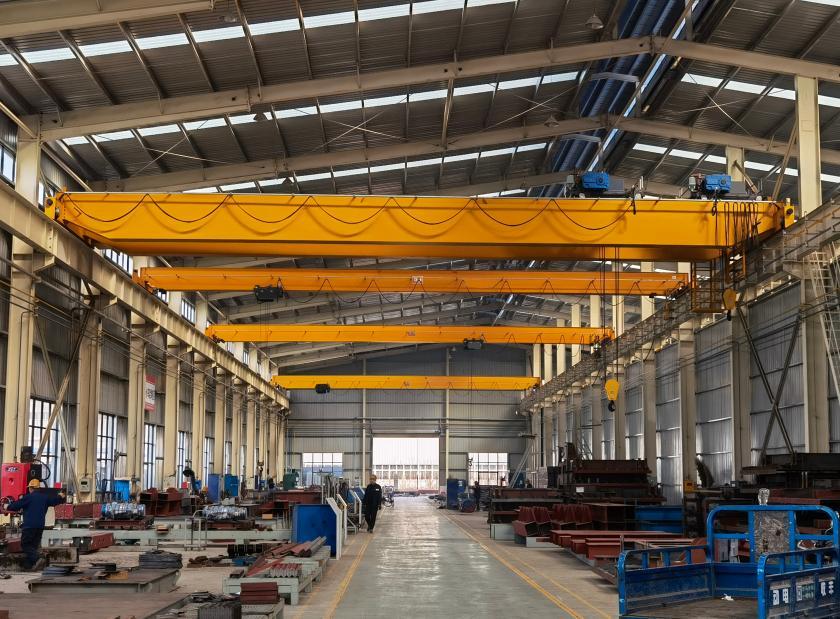
Cost-Benefit Analysis: Investing in Factory Overhead Cranes
Le 01/05/2025
Factory overhead cranes are essential for a wide variety of industries, from manufacturing to logistics. They provide solutions to material handling and lifting tasks, allowing factories to operate more efficiently. However, investing in overhead cranes involves a substantial initial cost, and businesses must weigh the potential benefits to make an informed decision. A thorough cost-benefit analysis is crucial for evaluating whether the investment will yield long-term advantages. In this article, we will explore the factors involved in the decision-making process for purchasing overhead cranes and how to assess their true value.
What Are Factory Overhead Cranes?
Factory overhead cranes, often referred to as overhead traveling cranes (OTC), are designed to lift and move heavy loads across the factory floor. These factory cranes consist of a bridge, hoist, and trolley system mounted on elevated tracks. They travel along a fixed path, allowing them to lift and transport materials with precision. Overhead cranes come in several types, including:
Single Girder Cranes: These are less expensive and suitable for lighter loads.
Double Girder Cranes: These can handle heavier loads and offer more durability.
Gantry Cranes: These are typically used for outdoor applications or on uneven floors.
Overhead cranes are used in industries like automotive manufacturing, steel production, construction, and general material handling, enhancing productivity and safety in these environments.

Factors to Consider When Investing in Overhead Cranes
Before deciding to invest in factory overhead cranes, several key factors need to be assessed. These factors will not only impact the initial cost of overhead crane but also its long-term operational performance and return on investment.
1. Initial Investment Costs
The first step in any cost-benefit analysis is to consider the initial investment. Overhead cranes can be expensive, especially for larger systems. The total cost includes:
Crane Type: Single girder cranes are less expensive, while double girder cranes, suitable for higher loads, tend to cost more.
Capacity: Cranes with higher load capacities, such as 50-ton cranes, will come at a higher price point compared to lighter capacity models.
Customization and Features: Advanced features like anti-sway technology, remote controls, or specialized control systems can add to the cost.
Installation and Training: Professional installation is critical for ensuring the crane's proper operation, and training employees on how to use it safely will also be part of the upfront investment.
It's essential to balance the crane's cost against its intended function and the factory's specific needs.
2. Operational Efficiency and Productivity Gains
A key benefit of investing in overhead cranes is the increase in operational efficiency. Cranes automate the process of moving materials, offering a variety of benefits:
Reduced Manual Labor
One of the primary advantages of factory overhead cranes is their ability to eliminate the need for manual labor in heavy lifting tasks. Workers no longer need to physically move materials, which reduces the risk of injury and boosts overall factory safety.
Faster Production Times
Overhead cranes can move materials quickly and efficiently across the factory floor, reducing downtime between different stages of production. This is particularly beneficial in high-volume manufacturing environments where minimizing delays is critical.
Improved Accuracy and Precision
Cranes equipped with modern control systems provide accurate handling of loads, minimizing the chances of errors or damage to products. This precision ensures that materials are transported exactly where they need to go, improving overall production flow.
By improving efficiency and reducing manual labor, factories can enhance productivity and reduce operating costs.
3. Maintenance and Longevity
The long-term performance of an overhead crane relies heavily on regular maintenance. While these cranes are durable, neglecting maintenance can lead to significant issues, such as mechanical failure and safety hazards. The costs associated with maintaining an overhead crane include:
Routine Inspections and Repairs: Cranes require periodic inspections to ensure that they are operating properly. Parts such as hoists, trolleys, and motors need to be checked and maintained regularly.
Replacement of Worn Parts: Over time, certain components may wear out, such as hoist ropes or drive motors. These parts need to be replaced to keep the crane operating efficiently.
Unexpected Breakdowns: While routine maintenance can prevent many issues, unforeseen problems can still arise, leading to repair costs and potential downtime.
Regular maintenance can extend the crane's lifespan, with most overhead cranes lasting between 20 to 40 years when properly cared for. Furthermore, investing in modern cranes with self-diagnostic systems can help detect issues early, reducing the risk of unplanned downtime and costly repairs.
4. Energy Consumption
Energy costs can add up over time, especially in older or less efficient crane models. Modern overhead cranes are designed to be energy-efficient, helping reduce electricity bills in the long run. When evaluating overhead cranes, consider the following:
Energy-Efficient Models: Newer cranes often feature energy-saving components such as variable frequency drives (VFDs), which adjust the motor speed to match the load.
Regenerative Braking: Some cranes are equipped with regenerative braking systems that return energy to the grid or use it for other operations, reducing energy consumption.
Investing in an energy-efficient crane may have a higher upfront cost, but the long-term savings on energy bills can offset this investment.
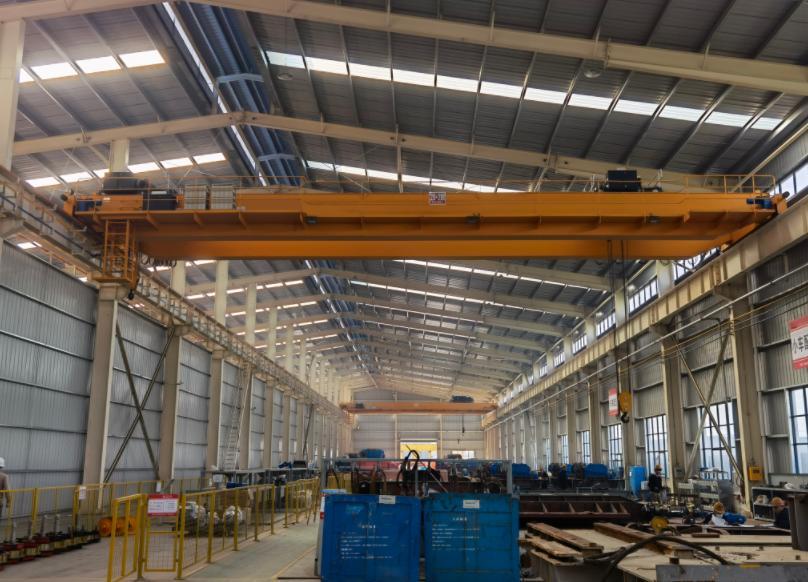
5. Safety and Compliance
Safety is a major concern when using overhead cranes, and investing in high-quality cranes with safety features is essential. Modern overhead cranes are equipped with safety mechanisms such as:
Anti-Collision Systems: Prevent collisions between the crane and other machinery or structures.
Load Sensors: Ensure that the crane does not exceed its weight capacity.
Emergency Stop Systems: Allow for quick shutdown in case of an emergency.
Complying with safety standards and regulations is vital to avoiding legal issues and maintaining a safe work environment. Non-compliance with safety regulations can result in costly fines, accidents, or even work stoppages. Investing in a crane that meets or exceeds safety standards can mitigate these risks and improve workplace safety.
6. Space Optimization
Overhead cranes use vertical space, freeing up valuable floor area for other operations. This is particularly beneficial for factories with limited floor space. By using the crane’s bridge to move materials overhead, factories can increase storage capacity, accommodate more equipment, and enhance workflow without needing additional floor space.
This space-saving feature can be particularly advantageous in smaller factories or manufacturing units that are operating at full capacity.
7. Return on Investment (ROI)
Calculating the return on investment (ROI) is essential when evaluating the purchase of an overhead crane. The ROI is determined by comparing the costs of purchasing, installing, and maintaining the crane with the long-term benefits it provides:
Labor Savings: The reduction in manual labor costs is one of the most immediate benefits of using an overhead crane.
Increased Productivity: Faster material handling translates to more products being produced in less time.
Reduced Accidents: Fewer workplace injuries due to heavy lifting or improper handling of materials result in lower insurance premiums and fewer days lost to accidents.
Improved Product Quality: Accurate and safe material handling helps prevent product damage, which can improve overall product quality and reduce waste.
A positive ROI means that the investment in the crane is paying off over time, leading to significant cost savings and increased profitability.
Conclusion: Weighing the Costs and Benefits
Investing in factory overhead cranes offers numerous benefits, including improved efficiency, enhanced safety, and long-term cost savings. While the initial investment may seem high, the potential for increased productivity, reduced labor costs, and minimized operational risks often justifies the expense. By conducting a thorough cost-benefit analysis and considering factors such as maintenance costs, energy efficiency, safety, and ROI, you can make a well-informed decision on whether an overhead crane is a good investment for your factory.
Ultimately, the right overhead crane will contribute to the long-term success of your operation, boosting productivity, optimizing space, and improving the safety of your workers.
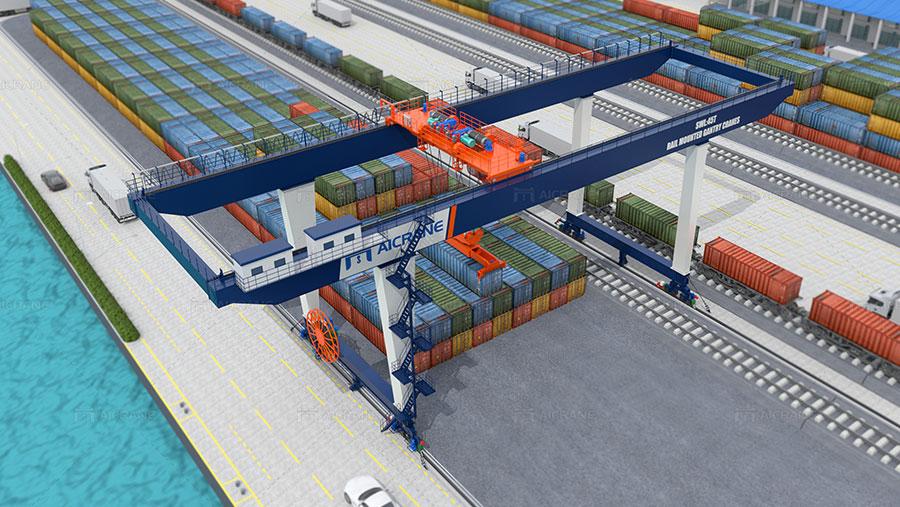
Why Gantry Crane Price Varies Based on Material Handling Needs
Le 30/04/2025
Gantry cranes, essential pieces of heavy lifting equipment used in various industries, are known for their versatility and ability to handle massive loads. They are designed to lift, move, and transport heavy materials across factories, construction sites, shipping yards, and warehouses. However, when it comes to purchasing a gantry crane, one of the most significant factors that can impact its cost is the material handling requirements of the specific application. The price of a gantry crane can vary widely depending on the type of materials it needs to handle, the required lifting capacity, and the operating environment. This article will explore why gantry crane prices vary based on material handling needs and the factors that contribute to these price fluctuations.

1. Load Capacity: The Foundation of Price Variation
The most obvious factor that affects the gantry crane price is its load capacity. Gantry cranes come in different weight ranges, and the lifting capacity is often directly proportional to the price of the crane. A crane with a higher load capacity typically costs more because it requires more robust materials, a stronger frame, and more advanced engineering to safely lift and move heavier objects.
Light-duty gantry cranes, typically used for lifting smaller materials or light to moderate loads, are less expensive. These cranes might have a lifting capacity of 1 to 10 tons and are ideal for applications such as small workshops, warehouses, or repair yards.
Heavy-duty gantry cranes, designed for industrial operations like steel mills, construction sites, or ports, can handle 100 tons or more. These cranes come with heavier-duty components, including reinforced beams, more powerful motors, and specialized hoisting mechanisms. Naturally, these features add to the cost.
Material handling needs that involve particularly heavy, bulky, or delicate materials often require gantry cranes with higher load capacities. For example, a crane used to transport large steel beams or ship components will be significantly more expensive than one used for smaller, lighter items. The greater the weight of the material that the crane needs to lift, the higher the design and manufacturing costs.
2. Type of Material Being Handled: Tailored Features for Specific Materials
Different materials have different handling needs. Gantry cranes designed for specialized tasks, such as lifting hazardous materials, oversized components, or extremely delicate items, come with unique features and equipment. These specialized needs influence the design, materials, and ultimately the price of the crane.
For example, cranes used in the steel industry need to have features that allow them to lift hot, heavy steel plates or coils. These cranes may include additional safety features such as heat-resistant coatings or specialized lifting attachments, which add to the overall cost.
Cranes used in the aerospace industry often require precision and delicate handling of aircraft components. The materials used in these cranes are designed to reduce the risk of damaging expensive parts, which can increase the price.
Handling hazardous materials such as chemicals or flammable substances requires gantry cranes equipped with specific safety features, such as explosion-proof motors, anti-static systems, and corrosion-resistant materials. These special features raise the price of the crane compared to standard cranes used for less sensitive applications.
When a gantry crane is designed to handle specific materials, the manufacturer must account for the properties of those materials, which leads to a more customized, and therefore more expensive, solution. For instance, cranes designed for concrete casting or for use in bulk material handling will have different specifications compared to those used in shipping ports for container handling.
3. Operating Environment: Outdoor vs. Indoor Use
The operating environment of a gantry crane significantly influences its design, which directly impacts its price. Gantry cranes that are used in harsh or outdoor environments require additional features to ensure their durability and reliability. For example:
Outdoor gantry cranes used in shipyards, construction sites, or port facilities need to be built with weather-resistant materials to withstand harsh conditions, such as rain, snow, extreme temperatures, and corrosive environments. The cost of materials and components needed to make these cranes weatherproof or resistant to corrosion will naturally drive up the price.
Indoor gantry cranes, on the other hand, generally have fewer environmental considerations. These indoor gantry cranes may not need to be as robust in terms of weatherproofing, but they may require additional safety features or quieter operations to meet specific workplace standards, particularly in environments where workers are close to the crane.
The climate and weather conditions in which the crane will be used also play a significant role in the price. For example, cranes used in high-humidity coastal regions may require additional corrosion-resistant coatings, which add to the cost. Similarly, if a crane is to be used in an extreme cold environment, it may require special components that prevent the machinery from freezing or malfunctioning, which increases the price.
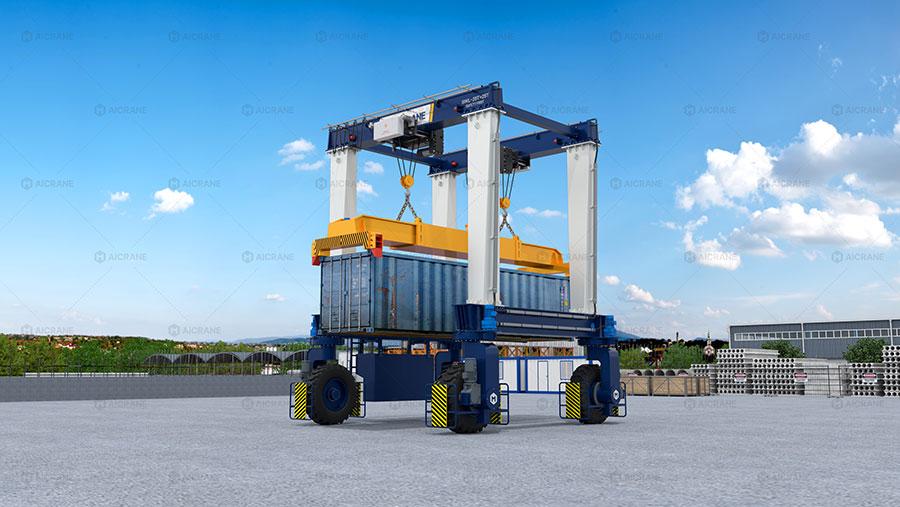
4. Lifting Height and Span: Additional Costs for Custom Features
In addition to the load capacity, the lifting height and span of a gantry crane are crucial factors that impact its price. The lifting height is the vertical distance the crane can lift its load, and the span refers to the horizontal distance between the crane’s support legs.
Cranes with a large span and high lifting height require more complex designs, additional engineering, and stronger materials to ensure stability and safety. These features can significantly raise the cost, especially when tailored to specific material handling requirements.
Custom gantry cranes designed to fit specific buildings, spaces, or material handling needs often come with a higher price tag. For example, a crane designed to handle oversized construction beams in a narrow factory space may need a unique span or height adjustment that requires extra fabrication and custom engineering.
5. Automation and Technology: High-Tech Cranes for Modern Demands
As industries continue to embrace automation, the integration of technology into gantry cranes has become a significant factor in determining their price. Cranes with automated features, such as remote control, automatic load positioning, and intelligent load monitoring systems, come with higher initial costs. These technological advancements improve the efficiency and safety of material handling processes but also raise the price of the crane.
Automated gantry cranes are often used in industries that require high throughput and precision, such as in container terminals or automated warehouses. The complexity of these systems requires more advanced sensors, software, and controllers, all of which contribute to the higher price.
Technology-driven safety features, such as anti-collision sensors, overload detection, and precise load control, are increasingly being added to cranes to improve safety and operational efficiency. These features, while beneficial, can also add to the overall price.
6. Customization and Specialized Design: More Specific Requirements, Higher Cost
Customization is another major factor that affects the price of gantry cranes. While standard gantry cranes may come at a relatively lower cost, a crane that is customized to meet the specific material handling needs of a business will be significantly more expensive.
For example:
Customized lifting attachments like spreader bars or lifting beams designed to handle specific types of loads (such as barrels, containers, or irregularly shaped components) can increase the cost.
Non-standard features like additional hoists, custom-built tracks, or unique control systems also drive up the price, as they require specialized parts and design expertise.
7. Maintenance and After-Sales Service: Additional Considerations
Finally, after-sales support and maintenance services can play a role in determining the overall cost of a gantry crane. Cranes that are designed to handle materials in heavy-duty or high-risk environments may come with extended warranties or additional maintenance packages to ensure they continue operating efficiently and safely. These add-ons can significantly affect the total price.
Conclusion
The price of a gantry crane is influenced by a multitude of factors that are directly tied to the material handling needs of a business. Whether it’s the load capacity, the type of materials being lifted, the operating environment, the height and span requirements, or the need for specialized features and technology, each aspect adds to the overall cost. When choosing a gantry crane, businesses need to assess their specific material handling requirements carefully to determine the most appropriate crane for their needs and budget.
In summary, while the initial price tag of a gantry crane may seem steep, understanding the material handling requirements and how they influence the design and features of the crane can help businesses make informed decisions. Investing in the right crane for the job is not just about cost—it’s about ensuring long-term performance, safety, and efficiency in the material handling process.
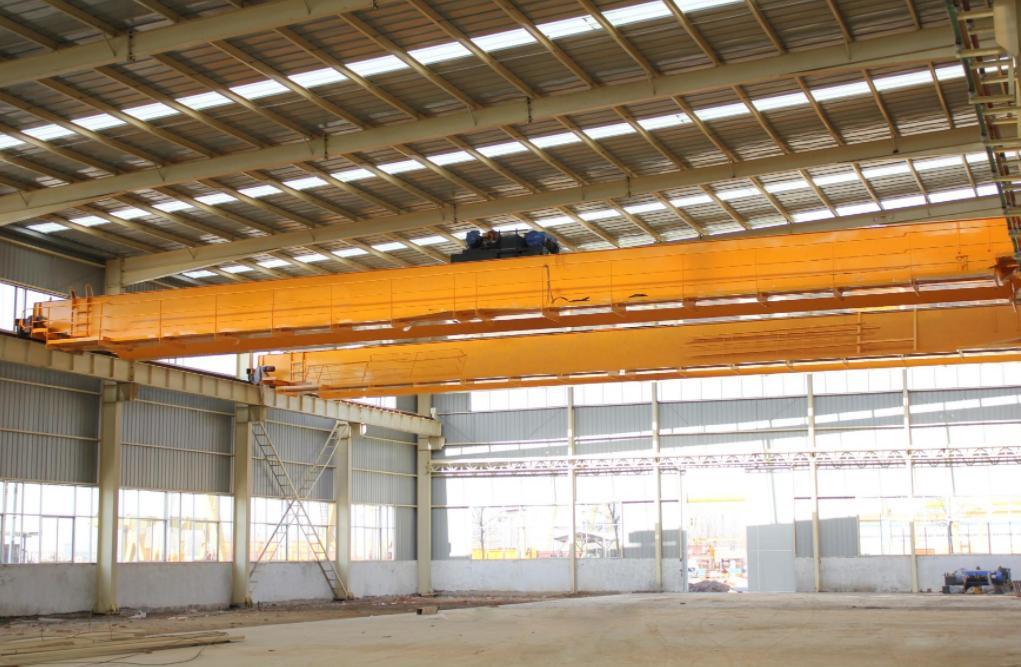
Overhead Crane Design for Explosion-Proof Environments
Le 28/04/2025
In industrial environments where flammable gases, dust, or vapors are present, ensuring the safety of equipment becomes a critical consideration. Among the essential equipment in such settings, overhead cranes are indispensable for transporting heavy loads, materials, and components. However, the risk of explosions in these environments requires specialized crane design to prevent any potential ignition sources that could lead to catastrophic accidents. This article explores the key aspects of designing overhead cranes for explosion-proof environments, covering the safety standards, design considerations, and best practices that help minimize the risk of explosions while maintaining operational efficiency.

Understanding Explosion-Proof Environments
Explosion-proof environments are defined as areas where the presence of flammable gases, vapors, or dust may create a potentially hazardous atmosphere. Such environments include:
Chemical plants: Areas where volatile chemicals are manufactured or processed.
Oil refineries: Locations where petroleum products are refined and processed.
Gas stations and storage facilities: Areas with the presence of fuel gases.
Grain silos and milling facilities: Areas with combustible dust from grains, flour, or other particulate materials.
In these environments, even a small spark or heat from an electrical component can ignite flammable substances, leading to dangerous explosions or fires. Consequently, the design and operation of overhead cranes in these areas must comply with strict safety standards to prevent such incidents.
Explosion-Proof Standards and Regulations
The design of overhead cranes for hazardous environments is governed by several international and local safety standards. These regulations are crucial in guiding manufacturers to produce explosion proof cranes that can withstand the unique challenges posed by explosive atmospheres. The primary standards include:
IECEx and ATEX Standards:
The IECEx (International Electrotechnical Commission Explosive Atmospheres) and ATEX (Atmosphères Explosibles) certification systems are international standards for equipment used in explosive atmospheres. These regulations outline the classification of hazardous zones (classified into Zone 0, Zone 1, Zone 2 for gases and Zone 20, Zone 21, Zone 22 for dust) and require that equipment used in these zones must be designed, manufactured, and certified as explosion-proof.
NFPA Standards:
The National Fire Protection Association (NFPA) provides guidelines for industrial and commercial safety. NFPA 70 (National Electrical Code) and NFPA 70E (Standard for Electrical Safety in the Workplace) are key standards when designing overhead cranes in hazardous environments. These guidelines ensure that electrical components are suitably protected against explosion risks.
OSHA Regulations:
The Occupational Safety and Health Administration (OSHA) enforces workplace safety standards, including for hazardous environments. In the U.S., OSHA references NFPA and IECEx/ATEX standards, requiring employers to use explosion-proof equipment when operating in volatile atmospheres.
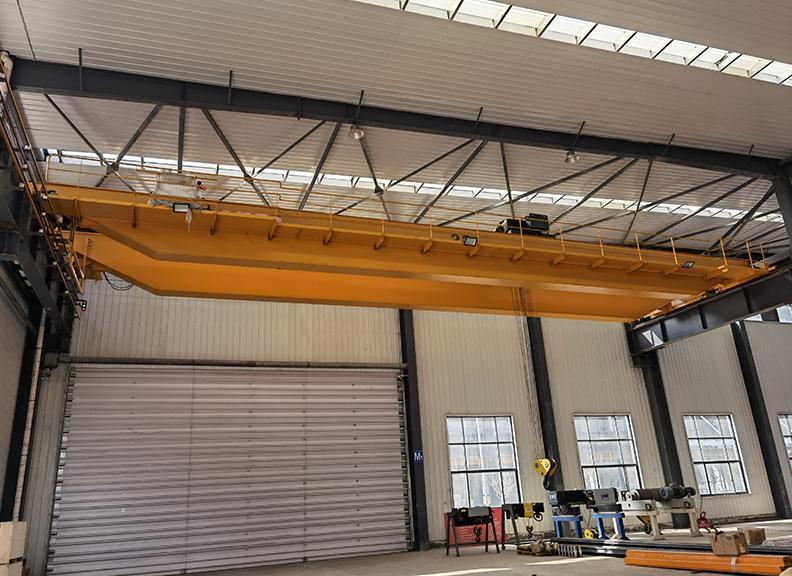
Key Design Considerations for Explosion-Proof Overhead Cranes
Designing an overhead crane for an explosion-proof environment requires careful consideration of several key factors. These include the crane's electrical system, materials used in its construction, mechanical components, and maintenance practices. Below are the critical aspects to consider:
1. Explosion-Proof Electrical Systems
The electrical system of an overhead crane for sale is often the most significant potential source of ignition in explosive environments. Therefore, all electrical components used in explosion-proof cranes must be designed to prevent sparks, electrical arcs, or overheating, which could ignite the surrounding atmosphere.
Explosion-Proof Motors: Motors used in overhead cranes must be housed in specially designed enclosures that prevent any ignition sparks from escaping. These enclosures are typically made of heavy-duty cast iron or steel and are sealed to ensure that no dust or gases can infiltrate the motor.
Intrinsically Safe Wiring and Controls: All wiring and control panels should meet the requirements for being intrinsically safe, meaning they are designed to operate below the temperature and energy levels that could ignite a flammable atmosphere. Additionally, wiring should be installed using explosion-proof conduits to prevent sparks from escaping.
Temperature Control: All electrical components must be thermally protected to ensure they do not overheat and become ignition sources. This may involve the use of temperature sensors, cooling systems, or explosion-proof venting.
2. Material Selection for Structural Integrity
The materials used in the construction of an explosion-proof overhead crane must be resistant to corrosion, wear, and impact while maintaining their structural integrity in the presence of hazardous substances. Common materials for explosion-proof cranes include:
Stainless Steel and Special Coatings: Stainless steel is often used for structural components as it offers excellent resistance to corrosion and can withstand harsh chemicals. Additionally, specialized coatings such as epoxy or zinc can be applied to prevent rusting and damage caused by flammable substances in the environment.
Non-Sparking Components: Cranes in explosion-proof environments should be built with non-sparking materials, especially for components like hooks, chains, and drums. These materials reduce the risk of igniting explosive dust or gases during operation.
3. Safe Operating Mechanisms
Overhead cranes in hazardous environments must feature safe operational mechanisms that do not pose a risk to personnel or cause accidental ignitions.
Explosion-Proof Brake Systems: Brakes used in the crane must be designed to operate safely in explosive environments. Explosion-proof brakes should be fitted to the crane to prevent overheating, which could lead to sparks and ignition.
Overload Protection: Overloading the crane in hazardous environments could cause strain on the equipment, leading to mechanical failures and creating potential ignition sources. Incorporating overload sensors, safety limiters, and automated shutdown systems can prevent such incidents.
Remote Control Operation: To reduce the risk of human error and exposure to hazardous zones, overhead cranes are often operated remotely. This minimizes the chances of sparks being generated from human activity or electrical contact in dangerous areas.
4. Explosion-Proof Enclosures for Control Systems
The control panels of an explosion-proof crane must be housed in explosion-proof enclosures to protect the electrical systems from hazardous environments. These enclosures are typically sealed and reinforced to prevent any sparks from escaping. Furthermore, the control systems should be designed to function without generating excessive heat or causing electrical arcs.
Automated Shutdown Features: In cases where there is a malfunction in the control system, the crane should automatically shut down to prevent any potential ignition sources. This is particularly important for maintaining safety in explosive environments.
5. Regular Maintenance and Inspections
In explosion-proof environments, overhead cranes must be regularly inspected and maintained to ensure their safe operation. Specialized maintenance procedures should be established to monitor and maintain the explosion-proof features of the crane, including:
Regular Inspections: Inspecting electrical systems, wiring, motors, and mechanical components ensures they are functioning as expected. Any signs of wear or damage should be addressed immediately.
Scheduled Replacements: Some components, such as seals and insulation materials, may degrade over time and require replacement. Scheduled maintenance ensures these components are replaced before they pose a safety hazard.
Cleaning Procedures: In environments with dust or other hazardous particles, cleaning procedures must be implemented to prevent buildup in the crane’s components. Dust accumulation could become an ignition source if not properly managed.
Best Practices for Safe Operation
Alongside proper design and construction, safe operation practices are essential to minimizing risks in explosive environments:
Operator Training: Operators should be thoroughly trained on how to operate cranes in hazardous areas, focusing on preventing sparks and avoiding overloads. They should also be aware of the proper emergency shutdown procedures.
Hazardous Zone Markings: Clearly marking hazardous zones around the crane's operational area helps ensure that workers maintain a safe distance from the crane's moving parts.
Proper Grounding: Proper grounding of all electrical components reduces the risk of electrostatic discharges, which could cause sparks and ignite flammable substances.
Conclusion
Designing an overhead crane for explosion-proof environments requires a careful balance of advanced engineering, materials science, and operational safety practices. Adhering to industry standards, such as IECEx, ATEX, and NFPA regulations, ensures that cranes can operate safely in environments with hazardous gases, vapors, or dust. By focusing on explosion-proof electrical systems, non-sparking materials, safe operating mechanisms, and ongoing maintenance, manufacturers can deliver overhead cranes that not only meet stringent safety requirements but also maintain operational efficiency. With proper design and safety measures in place, overhead cranes can continue to be an invaluable tool for industries working in explosion-prone environments.
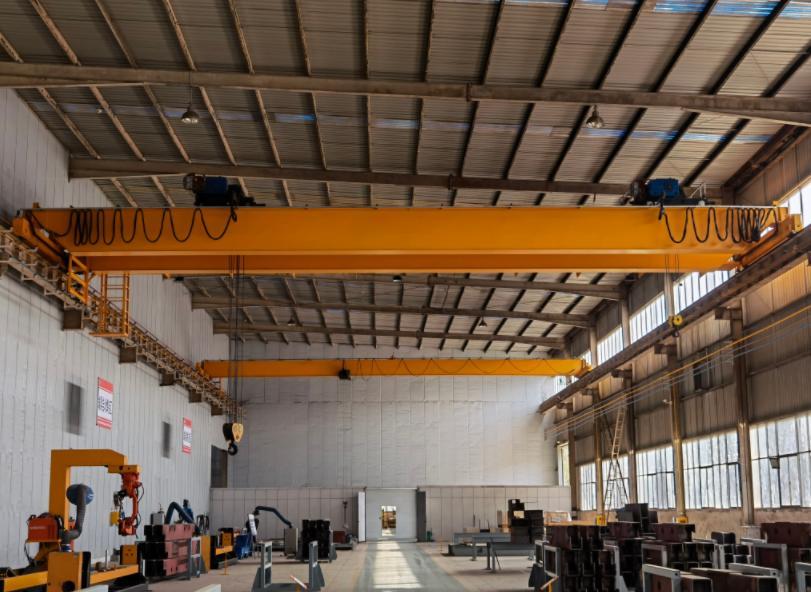
50-Ton Overhead Crane Safety Features You Should Know About
Le 27/04/2025
Overhead cranes are essential in many industries for lifting and moving heavy loads. A 50-ton overhead crane, in particular, is a vital piece of equipment in environments such as steel mills, construction sites, and manufacturing plants, where lifting substantial loads is a regular necessity. However, with the massive weight capacity comes significant safety concerns that need to be addressed to prevent accidents, injuries, and property damage. To ensure the safe operation of a 50-ton overhead crane, it is essential to understand the safety features that are incorporated into the design, operation, and maintenance of the crane.
In this article, we will explore the critical safety features of a 50 ton overhead crane that you should know about to ensure both the safety of operators and the efficiency of crane operations.

1. Overload Protection System
One of the most important safety features of any crane, including a 50-ton overhead crane, is the overload protection system. Overloading a crane is one of the leading causes of crane accidents, as exceeding the rated load capacity can lead to mechanical failure, tipping, or even collapse of the crane structure.
An overload protection system is designed to monitor the crane’s load in real time. If the load exceeds the crane’s maximum capacity (50 tons in this case), the system will automatically stop the lifting operation to prevent overloading. This feature is crucial for preventing damage to the crane’s hoist, trolley, and structural components, as well as avoiding potential catastrophic accidents.
The overload protection system is often integrated with the crane’s control panel, allowing the operator to easily view real-time load data. It may also include an audible alarm or visual indicator to alert the operator if the double girder overhead crane is nearing or exceeding its rated load limit.
2. Limit Switches
Limit switches are another essential safety feature on a 50-ton overhead crane. These devices help to prevent the crane from exceeding its safe operating limits by restricting the movement of the crane’s hoist, trolley, and bridge.
Limit switches are typically installed at the end of the crane’s travel path, both horizontally and vertically. For example, when the hoist reaches the maximum lifting height, a limit switch will automatically stop the motion to prevent further travel that could damage the crane or the load. Similarly, horizontal limit switches ensure that the crane’s trolley does not move beyond the safe operational boundaries.
These switches are critical for preventing mechanical damage to the crane and for maintaining control over the crane’s operation. They also help avoid safety hazards associated with lifting or transporting heavy loads beyond the crane's designed capabilities.
3. Safety Locking Mechanisms
Safety locking mechanisms are used on critical parts of the crane, such as the hook and the hoisting mechanism, to prevent accidental disengagement or unexpected movements during operation. These mechanisms ensure that the hook, which is responsible for lifting the load, remains securely attached to the load and does not accidentally release it during operation.
In many 50-ton overhead cranes, safety latches or locks are built into the hook assembly to keep the hook securely fastened to the load. This feature is essential to prevent accidental load detachment, which could lead to dangerous situations, especially in high-rise construction or heavy lifting tasks.
The safety locking mechanism can also be integrated with sensors and alarms that notify the operator if the safety lock is not properly engaged or if there is any risk of a detachment.
4. Anti-Sway Systems
In heavy lifting applications, especially when lifting loads with a large mass, one of the challenges faced by crane operators is the risk of load sway. When a load swings during transportation, it can cause instability, making the crane more difficult to control and increasing the risk of accidents.
An anti-sway system is designed to mitigate the effects of load sway. This system uses sensors, feedback loops, and sophisticated algorithms to detect the movement of the load and automatically adjust the crane’s speed and movement patterns to reduce swaying.
For a 50-ton overhead crane, which is likely to carry large, heavy, and potentially awkward loads, an anti-sway system is crucial for ensuring smooth, controlled, and precise handling. The system helps to minimize risk by preventing unpredictable load swings that could lead to damage to surrounding infrastructure or injuries to workers in the vicinity.
5. Operator Control Systems
The operator is one of the most significant factors in the safety of a 50-ton overhead crane. Therefore, an effective operator control system is essential for providing clear, intuitive, and responsive control over the crane’s movements.
Modern overhead cranes typically include both ground-based and remote control systems. These systems allow the operator to control the crane from a safe distance, reducing the risk of injury. Additionally, remote controls may offer features like emergency stop buttons, speed control, and direction adjustments to enhance safety.
The operator control systems often include safety interlocks that prevent the crane from operating under unsafe conditions, such as if the crane is not in the correct position or if there is a malfunction in one of the crane’s systems. These control systems are typically designed to be user-friendly, with clear indicators that help operators make quick decisions and maintain a high level of safety.
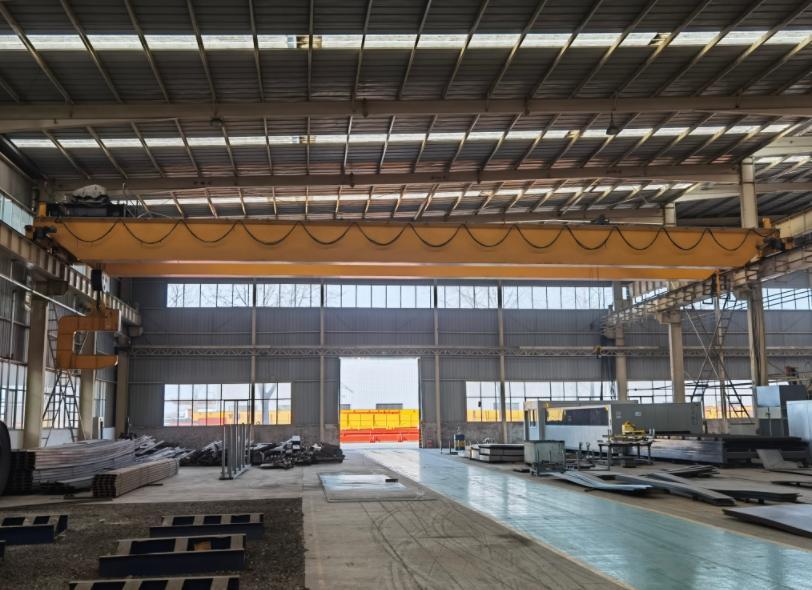
6. Warning and Signal Systems
Clear communication is critical for safety when operating a 50-ton overhead crane, especially in busy or crowded environments. Warning and signal systems provide vital information to both the crane operator and nearby workers about the crane’s operation.
Warning systems often include audible alarms, flashing lights, or signal horns that alert people in the vicinity of the crane when it is in operation. These signals are especially important in environments where the operator's visibility is limited or when workers may be unaware of the crane's movements.
In addition to these physical signals, visual displays on the crane’s control panel provide the operator with real-time data about load weight, crane position, and other crucial parameters. This data helps the operator make informed decisions, reducing the risk of accidents and ensuring smooth operations.
7. Emergency Stop Mechanisms
An emergency stop system is a fundamental safety feature on all 50-ton overhead cranes. This system is designed to immediately halt crane operations in the event of an emergency or if a dangerous situation arises. An emergency stop button is usually located in multiple locations, including on the operator’s control panel and on the crane’s structure itself.
The emergency stop system is a critical tool for preventing accidents and injuries in situations where immediate intervention is necessary. For example, if the crane encounters a mechanical failure, or if a worker enters a dangerous area, the operator can quickly stop the crane’s operation to prevent harm.
The emergency stop mechanism is often integrated with the crane’s other safety features, such as the overload protection system and limit switches, to provide an added layer of security in case of emergencies.
8. Regular Maintenance and Inspections
Regular maintenance and inspections are essential for ensuring that all safety features of the 50-ton overhead crane remain in optimal working condition. Cranes should be inspected periodically for wear and tear, and any malfunctioning safety systems should be immediately addressed.
A maintenance schedule should be established based on the manufacturer’s recommendations, and it should include checks for key components such as hoists, limit switches, safety locks, and wiring. In addition, safety audits should be conducted regularly to ensure that the crane is compliant with industry standards and safety regulations.
Operators should also be trained to perform routine visual checks before using the crane, ensuring that all safety systems are in place and functioning correctly.
Conclusion
The safety of a 50-ton overhead crane is paramount for both the operator and the surrounding workers. Incorporating safety features like overload protection systems, limit switches, anti-sway systems, safety locking mechanisms, and emergency stop features ensures that the crane operates smoothly, preventing accidents and damage.
By investing in these safety systems, training crane operators thoroughly, and performing regular maintenance, industrial facilities can enhance the safety and reliability of their 50-ton overhead cranes, keeping both their workers and their operations safe.
Tailored Design of RMG Cranes for Container Handling: Enhancing Efficiency and Precision
Le 25/04/2025
In the world of modern logistics, container handling plays a crucial role in ensuring the smooth operation of ports, shipping yards, and container terminals. As container handling demands continue to grow in terms of volume and efficiency, the use of Rail-Mounted Gantry (RMG) cranes has become indispensable. These cranes are specialized for loading and unloading containers from trucks, trains, and ships. One of the standout features of RMG cranes is their ability to be tailored to meet the specific needs of a port or terminal, optimizing their performance and ensuring operational efficiency. This article explores the importance of tailored design in RMG cranes, discussing how custom features can enhance container handling operations and improve safety, productivity, and cost-effectiveness.
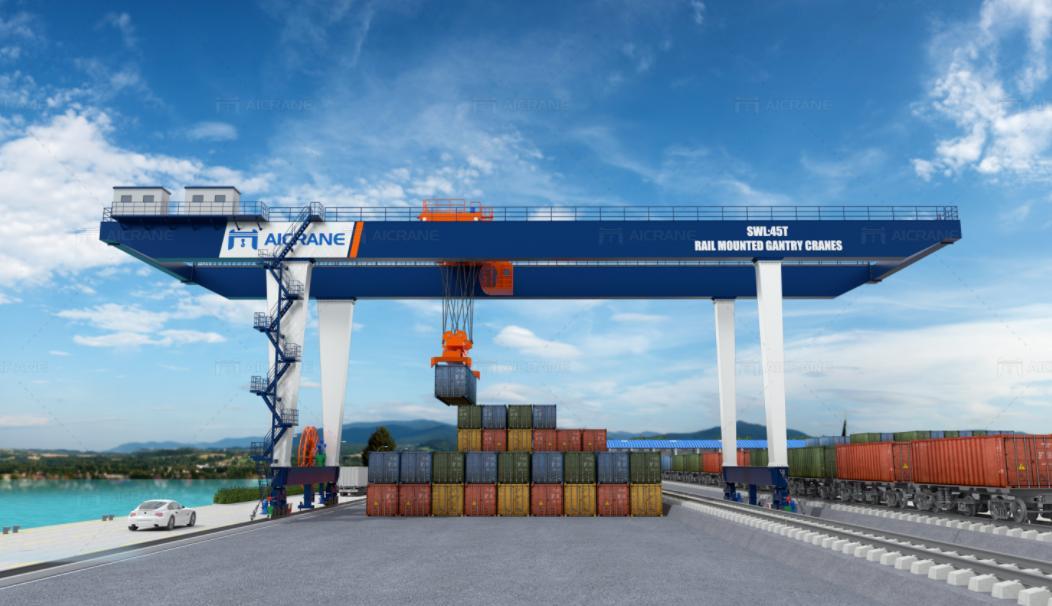
The Importance of RMG Cranes in Container Handling
RMG cranes are commonly found in container yards and ports, where they are responsible for stacking and retrieving containers from the ground or moving them to and from railcars and trucks. These cranes are mounted on rails, which provide a stable and controlled movement along the yard, allowing them to work with high precision. Their role is crucial, as they help manage large quantities of containers that need to be transported, stored, or loaded/unloaded with minimal delay.
Unlike traditional gantry cranes, which may be used for lifting other heavy loads in various industrial settings, rail mounted gantry cranes are specifically designed for container handling. They offer features such as adjustable spreaders, precise hoisting mechanisms, and advanced control systems to ensure containers are handled safely and efficiently. The demand for higher throughput, reduced operation costs, and minimal environmental impact is driving the development of tailored RMG cranes for specific applications.
The Benefits of Tailored Design
1. Optimized Performance for Specific Applications
One of the primary reasons for opting for a tailored design for RMG cranes is the ability to optimize the crane for specific operational needs. Container terminals face various operational challenges based on factors like layout, available space, and the types of vessels or cargo they handle. By designing RMG cranes that are tailored to the unique requirements of the terminal, businesses can ensure that their equipment will perform optimally.
For example, a terminal with limited space may require an RMG crane that offers a smaller footprint but can handle heavy-duty operations. Alternatively, a terminal handling oversized containers may need a crane with specialized lifting mechanisms and extended reach capabilities. Tailored design ensures that the crane is built with the right features to meet the particular demands of the facility.
2. Increased Throughput and Efficiency
Container handling operations can benefit greatly from custom-tailored RMG cranes, particularly in terms of improving throughput and reducing cycle times. By adjusting key design elements like the lifting height, span, and speed of the crane, manufacturers can create RMG cranes that are better suited to the specific operations of a terminal.
For example, a port that primarily handles small to medium-sized containers might require an RMG crane that is optimized for faster lifting speeds and quicker turnaround times. On the other hand, terminals handling larger containers may need a crane designed for greater lifting capacity and additional hoisting precision. Customizing the crane's specifications can help increase throughput and reduce the time needed for each container move, resulting in better overall efficiency.
3. Enhanced Safety Features
Safety is paramount in any crane operation, and this is especially true for container handling, where heavy lifting is involved. Tailored RMG cranes can be designed with additional safety features that address specific hazards in the terminal environment. These features might include improved anti-sway systems, load monitoring technologies, and enhanced braking systems.
Anti-sway technology, for example, helps minimize the swinging of containers during hoisting, preventing accidents and reducing the risk of damage to both the container and the crane. In addition, load monitoring systems ensure that containers are lifted within the crane's safe working load limits, protecting both the equipment and the workforce.
By tailoring the crane’s safety features to the unique conditions of the terminal, it is possible to mitigate risks and enhance operational safety.
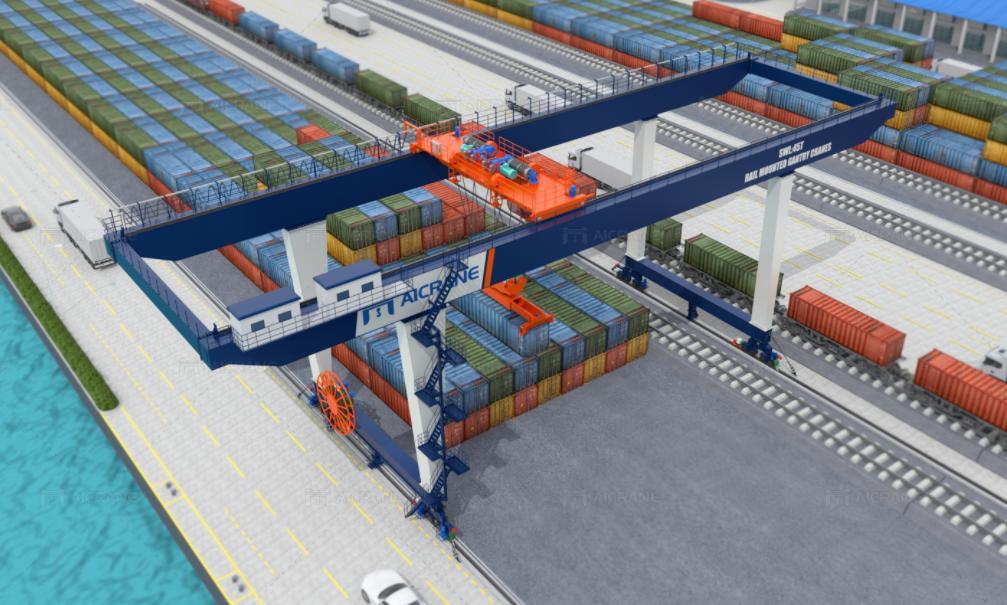
4. Cost-Effectiveness and Energy Efficiency
Tailoring RMG cranes to meet the specific needs of a terminal can also have significant cost benefits. When cranes are designed with efficiency in mind, they can reduce energy consumption and minimize operating costs. For example, an RMG gantry crane for container handling designed to handle lighter loads at a faster pace may be built with energy-efficient motors and drive systems to reduce electricity usage, making the crane more cost-effective over time.
Moreover, customizing the crane's design allows businesses to avoid the expense of over-specifying equipment. A terminal that does not require the highest lifting capacity or the longest span can save money by opting for a more appropriately sized crane, reducing both upfront capital investment and maintenance costs.
5. Flexibility for Future Growth
Container terminals are dynamic environments that often experience fluctuations in demand, changes in cargo types, and the introduction of new technologies. One of the key advantages of designing RMG cranes with tailored features is the flexibility to adapt to future requirements.
For example, a crane can be equipped with modular components that allow for easy upgrades as operational needs change. This could include the addition of new hoisting systems, increased lifting capacity, or the ability to handle different types of containers as the terminal evolves. By planning for future growth, businesses can ensure that their RMG cranes continue to meet their needs for years to come.
Key Design Elements for Tailored RMG Cranes
Several key design elements should be considered when customizing an RMG crane for container handling:
1. Lifting Capacity
The lifting capacity is one of the most critical design factors for an RMG crane. It determines the weight of the containers the crane can lift, and ensuring that the crane has the correct capacity for the terminal's typical loads is essential. A crane with too high a capacity may be more expensive and inefficient, while one with insufficient capacity may struggle to handle larger containers, leading to operational delays.
2. Span and Lifting Height
The span of the crane determines how far it can reach across the yard, while the lifting height dictates how high it can raise containers. Tailoring these dimensions ensures that the crane can effectively cover the terminal’s layout and stack containers at the required height. The crane’s reach must be aligned with the container storage configuration to avoid unnecessary congestion and optimize yard space utilization.
3. Control Systems and Automation
Incorporating advanced control systems into RMG cranes is another key area for customization. Modern RMG cranes often come equipped with automated or semi-automated features that reduce human error and improve efficiency. These systems include GPS tracking, load measurement sensors, and remote operation capabilities. Automation can also streamline processes such as stacking containers, enhancing throughput and reducing labor costs.
4. Stability and Anti-Sway Systems
RMG cranes can experience instability when lifting containers, especially during high winds or with large loads. Tailoring the crane’s stability system to meet the unique environmental conditions of the terminal is essential. Anti-sway systems, along with advanced load monitoring and stability enhancements, can ensure smooth and safe container handling in challenging conditions.
5. Environmental Considerations
As environmental concerns become more pressing in industrial settings, many container terminals are opting for energy-efficient RMG cranes. Customization can include the selection of low-emission power sources, energy-saving motors, and eco-friendly materials in the crane’s design. Additionally, the use of electric-powered cranes instead of diesel-powered ones can significantly reduce a terminal’s carbon footprint and operating costs.
Conclusion
Tailoring the design of RMG cranes for container handling is a strategic approach that can greatly enhance the operational efficiency, safety, and cost-effectiveness of a terminal. By considering factors such as lifting capacity, span, hoisting mechanisms, control systems, and automation, businesses can create cranes that are optimized for their specific needs. The ability to customize key design elements ensures that RMG cranes can adapt to the changing demands of the container handling industry, providing long-term benefits for both port operators and clients. As container handling technology continues to evolve, the importance of tailored crane design will remain a critical factor in maintaining competitive advantage and operational excellence in the global logistics landscape.
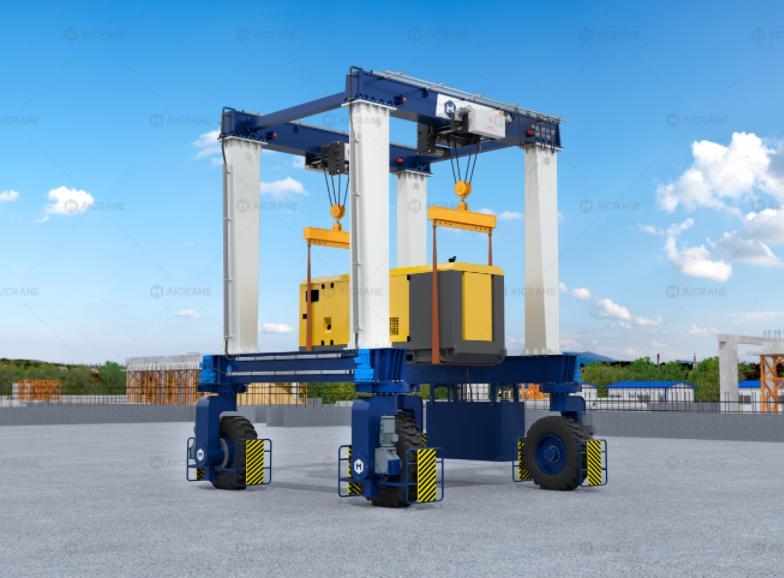
Innovations in Rubber Tyred Gantry Crane Frame Design
Le 24/04/2025
Rubber Tyred Gantry (RTG) cranes have become a fundamental part of the modern logistics and port industries, providing flexible and efficient solutions for container handling. These cranes are particularly beneficial in environments where mobility and versatility are critical. They are capable of moving freely along tracks or designated paths without the need for a fixed foundation, making them ideal for port terminals, warehouses, and construction sites. As industries demand higher efficiency and performance, the design of RTG crane frames has seen significant innovations in recent years.
In this article, we will explore some of the latest innovations in rubber tyred gantry crane frame design, focusing on the materials used, structural enhancements, and technological advancements that are shaping the future of these essential machines.
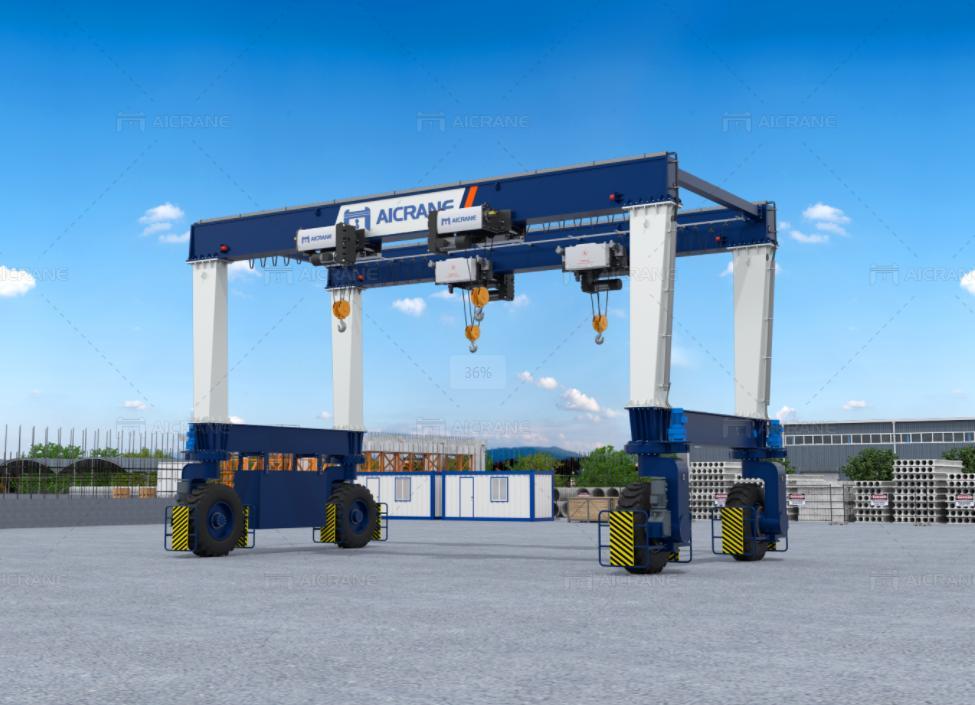
1. Lightweight and High-Strength Materials
One of the most significant innovations in RTG crane frame design has been the development and incorporation of lightweight, high-strength materials. Traditionally, crane frames were made of heavy steel, which, while strong, added substantial weight to the crane. This weight impacts not only the mobility of the crane but also its fuel consumption and overall efficiency.
Recent advancements in material science have led to the development of advanced steel alloys and composite materials that offer a higher strength-to-weight ratio. These materials are designed to withstand the intense forces and stresses exerted on crane frames during lifting and transportation, while reducing the overall weight of the crane. As a result, the crane becomes more fuel-efficient, requiring less power to operate, and it can also handle heavier loads without compromising stability.
Some manufacturers have also started experimenting with aluminum alloys in non-structural parts of the crane, further reducing weight without sacrificing performance. The use of these lightweight materials has enabled RTG cranes to achieve greater lifting capacities and improved maneuverability.
2. Modular and Flexible Frame Designs
The increasing demand for customizable and scalable RTG cranes has driven the trend toward modular frame designs. Modular RTG cranes offer the advantage of flexibility, allowing the crane frame to be easily adapted to different operational needs and environmental conditions. The ability to configure the frame in a modular fashion also allows for easier repairs and maintenance.
Modular frame designs typically consist of pre-fabricated components that can be assembled on-site. These components can include base frames, wheel structures, cross beams, and lifting gloves, all of which can be interchanged or upgraded as needed. For example, if a port terminal needs to increase the lifting capacity of its RTG cranes, additional components can be added to the existing frame, such as larger lifting arms or more robust wheel systems, without requiring a complete overhaul of the machine.
Furthermore, the modular approach allows manufacturers to offer customizable RTG cranes that can be tailored to meet specific operational requirements, such as different container sizes, lifting heights, or travel distances. This flexibility is crucial in environments where container handling needs can vary greatly.
3.Enhanced Stability and Safety Features
As RTG cranes are used in environments that often involve uneven ground conditions and variable weather, ensuring stability is paramount. Recent innovations in frame design have focused on improving crane stability, especially during lifting operations.
One such innovation is the development of advanced anti-sway systems that work in tandem with the crane's frame structure. These systems help to reduce the swinging motion of the load, ensuring that the crane remains stable and that the load is safely and precisely positioned. Anti-sway technologies are integrated into the crane frame through sophisticated sensors and control systems, which monitor the crane's movement in real-time and adjust the crane's actions to minimize sway.
Additionally, improvements in the wheel and axle design have contributed to the stability of RTG cranes. Modern RTG cranes feature advanced wheel systems with high-torque motors, which distribute the load more evenly and reduce the stress on individual wheel assemblies. This not only improves the crane's stability but also enhances its longevity, as the load is shared across more points of contact.
Some cranes also incorporate a load-sensing system in the frame, which helps operators determine if the mobile gantry crane is lifting a load that exceeds its designed capacity. If the crane is overloaded, the system will trigger a warning or automatically adjust the lifting speed to prevent damage to the crane or injury to workers.
4. Smart Crane Frame Technology and Automation
Incorporating smart technologies into the frame design has been one of the most transformative innovations in RTG crane development. Smart technologies have the potential to improve the efficiency, safety, and overall performance of RTG cranes by providing real-time data about the crane's operation and condition.
For example, modern RTG cranes are now equipped with IoT sensors embedded within the frame. These sensors monitor critical aspects of the crane's performance, including load weight, wheel wear, engine temperature, and hydraulic pressure. This data is transmitted to a central control system, where it can be analyzed to detect any potential issues before they become serious problems. Predictive maintenance models, driven by this data, enable operators to carry out repairs and maintenance only when necessary, reducing downtime and operating costs.
Another exciting development is the use of automation in RTG cranes. Fully autonomous RTG cranes are now being tested and deployed in ports around the world. These cranes are designed to move containers and perform lifting operations without human intervention. The frame of these cranes is equipped with a suite of sensors and cameras that allow the crane to navigate the terminal and interact with other machinery autonomously. This innovation has the potential to revolutionize the port industry by increasing efficiency and reducing human errors.
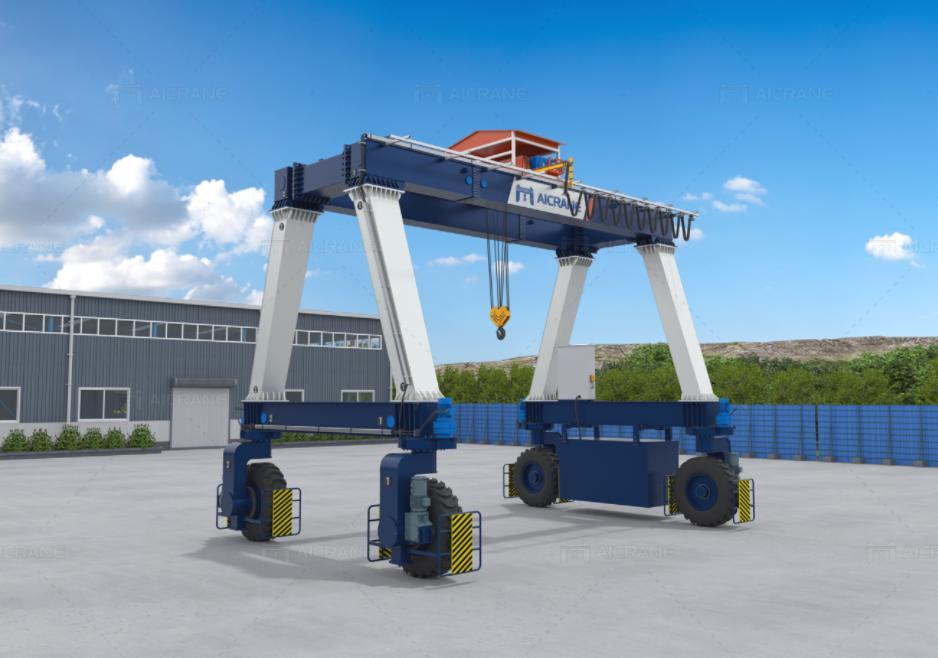
5. Energy-Efficient Designs
As the global focus on sustainability and energy conservation intensifies, energy-efficient designs have become a key consideration in RTG crane frame development. The modern RTG crane is expected not only to perform efficiently but also to minimize its environmental impact.
One of the key innovations in energy efficiency is the integration of hybrid or fully electric power systems. Traditionally, RTG cranes relied on diesel engines, which contributed to high fuel consumption and emissions. However, newer models now feature hybrid engines that combine diesel with electric motors, allowing the crane to switch between fuel types depending on the task. For example, during low-load operations, the crane may rely solely on electric power, reducing fuel consumption and emissions.
Electric RTG cranes have also seen improvements in their frame design to accommodate high-voltage batteries and power management systems. These cranes can be charged via an overhead power supply or through a battery swapping system, further reducing their environmental footprint. This shift toward electric power not only contributes to sustainability but also reduces operating costs over the long term.
6. Corrosion-Resistant Frame Coatings
The exposure of RTG cranes to harsh environmental conditions—such as saltwater, extreme temperatures, and heavy rainfall—can cause corrosion over time. To combat this, manufacturers have introduced advanced corrosion-resistant coatings for crane frames.
These coatings are designed to protect the metal components of the crane from rust and deterioration, extending the crane's lifespan and reducing the need for frequent maintenance. Innovations in this area have led to the development of coatings that not only resist corrosion but also enhance the crane's aesthetic appearance, making them more durable and attractive for long-term use.
Conclusion
Innovations in Rubber Tyred Gantry crane frame design have dramatically improved their performance, safety, and efficiency. The introduction of lightweight materials, modular designs, enhanced stability features, smart technology, energy-efficient systems, and corrosion-resistant coatings has positioned RTG cranes as a cornerstone of modern container handling. These innovations are not only addressing the growing demand for higher capacity and performance but are also helping to ensure that RTG cranes meet the evolving needs of the global logistics and port industries in a sustainable and cost-effective manner.
As the industry continues to innovate, it's clear that the future of RTG cranes will be defined by smarter, more efficient, and environmentally friendly designs. Manufacturers who embrace these advancements will be well-positioned to meet the needs of an increasingly competitive and eco-conscious market.